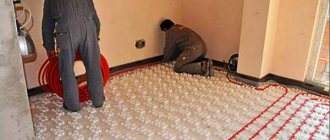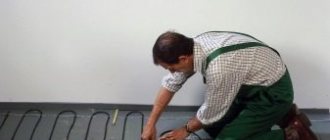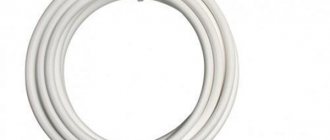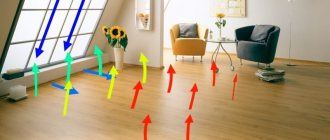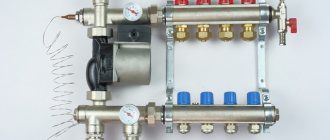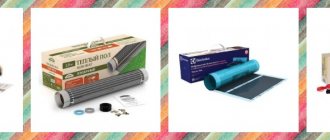Since ancient times, people have laid tiles on the floors of toilets and bathrooms. Over time, it was replaced by a more modern material made of porcelain stoneware. However, both of these finishing materials have one thing in common - they are cold to the touch. It is not very pleasant, after warming up in a hot bath, to step barefoot on the icy surface of the floor. Therefore, many residents are in favor of electric heated floors laid under the tiles.
Installation of an electric mat under tiles
And the optimal heating option in this case would be electric mats. Is it possible to independently install a heated floor system in separate rooms of an apartment or private house, what materials will be needed for this, and how to correctly calculate their quantity?
Types of heating mats
There are two types of heating mats that help create an atmosphere of warmth and comfort in rooms where it is necessary to maintain an increased level of comfort.
- Cable mats are rolled material designed for floor heating. They are based on a single-core or two-core resistive cable, attached with a snake to a polymer mesh. For convenience, some manufacturers provide the mesh with a self-adhesive bottom layer. The floor surface is heated by the heat generated by the conductor during the passage of current. Air heated near the floor surface rises. As a result, air exchange occurs in the room, due to which a comfortable temperature is achieved.
Cable mats - Infrared mats are the same rolled material. However, it does not consist of a cable, but of carbon rods attached to live wires. Despite the absence of a backing, the wires located on both sides of the rods give the material the necessary rigidity, making their installation easier. Carbon rods emit infrared waves that heat not only the floor surface, but also surrounding objects, which transfer heat to the air. Infrared mat
Laying both types of mats is done in the same way. The heating elements are placed either in a concrete screed or under a tile, where a cement-sand mixture replaces tile adhesive.
Advantages and disadvantages
Advantages and disadvantages of using mats
The use of mats as a thermal insulation substrate provides the following advantages:
- Compliance with fire safety standards; in case of fire they self-extinguish.
- Non-toxic and environmentally friendly.
- Elasticity – maintaining shape throughout the entire service life;
- resistance to temperature fluctuations when turning the heated floor on and off (from +180 to -180 degrees);
- Chemical inertness, resistance to bacteria, rotting, oxidation.
- Water repellency. The mats will prevent water from leaking to the lower floors in the event of pipe ruptures.
- Easy to install. The presence of additional fastening sections where underfloor heating pipes are placed makes the installation process easier. Installing a pipeline according to any chosen scheme does not take much time.
- Due to the presence of installation markings on mats for heated water floors, the efficiency of heat distribution in the room increases.
- long service life.
The only drawback of quality mats is their high cost. But if we take into account the entire “budget” of a heated floor, it is very acceptable, since the costs are fully justified in the near future by significant savings in paying energy bills.
Expanded polystyrene mats for warm water floors with bosses reduce the noise level in the room by up to 25 dB.
Arrangement of mats
All cable mats are divided into two types:
- single-core;
- two-core.
Single and double core cable mat
Each of them has its own installation and operation features.
Single-core cable mats consist of a polymer mesh on which a cable of a certain diameter is laid and maintaining a certain distance between the loops. The design of such mats consists of a single core made of brass or other material. The resistance resulting from the application of electricity helps to heat the material.
Structure of a single-core cable
Safety during operation of the heated floor system is achieved by several layers of insulation that cover the core. The maximum heating temperature is about 80°C, but the insulation can withstand more intense heating.
The design of a single-core cable affects its service life, which increases or decreases depending on the heating intensity. This means that as the heating temperature decreases, the service life of the cable increases significantly.
But in this case, to maintain the optimal temperature in the room, you will have to increase the consumption of material.
Twin-core mats consist of the same polymer mesh on which a cable consisting of two cores is fixed. Its device significantly increases the heating power of the system.
Diagram of a two-core heating cable
Despite the fact that during the installation and operation of single-core and two-core underfloor heating systems there is no significant difference, connecting the second option is much easier. Twin-core mats are connected by closing the contacts at the ends of the cable with each other. Connection of single-core systems is carried out by supplying two cold ends of the cable.
Installation of heating mats
[ads-mob-1][ads-pc-1]
Criterias of choice
What to look for when choosing
When choosing mats, you first need to ensure the authenticity of the material. The construction market is saturated with a variety of fakes, and given strict requirements for the properties and functions of thermal insulators, a mistake in this matter will be very expensive. Therefore, you should not neglect checking the certificates of conformity and safety, as well as the availability of a product warranty.
In order not to make a mistake when choosing the appropriate option, you should pay attention to:
- level of waterproofing;
- the ability of a particular model to withstand static and dynamic loads;
- pipe diameter suitable for installation in this type;
- requirements for the room in which installation work will be carried out.
The double lock on the mats reduces heat loss and increases the strength of the connection. Installation of such material is very easy and quick without much difficulty.
There are also a number of additional options:
- Thickness. When selecting material, take into account the height of the screed layer and decorative coating. In rooms with already installed insulation, you can take material of small thickness.
- If there is a choice, without any doubt, preference should be given to mats with a foil or laminating top layer. This will immediately solve the issue of waterproofing before pouring the screed, and in addition, will increase the efficiency of the floor heating system.
- Pay attention to the compliance of the mat parameters with the planned diameter of the circuit pipes and the pitch of its installation - discrepancies cannot be excluded here.
- Consider the area of the room in which you plan to lay the pipes. If the area is large, then you should give preference to material with “bobs”.
Review of the best brands and manufacturers
Which brands are trustworthy?
Many domestic and foreign manufacturers offer high-quality products. According to reviews from specialists and buyers, products manufactured under the following trademarks deserve special attention:
- Oventrop;
- Rehau;
- Energoflex;
- Ecopol.
The following brands of mats are in greatest demand among buyers:
Knauf Therm PRO
Designed for laying the water circuit in 50 mm increments. The material bosses have special protrusions and reliably fix heating pipes with a diameter of 14 - 17 mm. Additional rigidity is provided by the rigid polystyrene film covering the mats. Markings are applied on both sides of the slabs. Locks are located around the entire perimeter. On the back side of the slabs there is a soundproofing surface. Material thickness – 45 mm. Base 25 mm. The size of the slabs is 1.2×0.6 m.
Varionova REHAU
The price of these mats is slightly higher than that of analogues offered by other manufacturers. This is due to the design features of the model and high quality. The material has high strength and can withstand significant loads. On top there is a black polystyrene film that provides the necessary level of waterproofing. The markings are on the reverse side. The laying step of pipes with a diameter of 14 - 17 mm is 5 cm. The height of the mat is 24 mm.
Foam shield WF16-50
Offer from a domestic manufacturer. Designed for installing a water floor with pipes with a diameter of 16 mm. The plates have a dense base with a thickness of 30 mm, providing the necessary level of thermal protection. Mounting openings are located in 50 mm increments. The size of the slabs is 100×100×5 cm.
NP-35 from Oventrop
Mats recommended for the installation of self-leveling floors and for the construction of concrete screeds. They have increased heat and sound insulation.
WLG-045
Roll-type slabs covered with polypropylene film. Suitable for pipes with a diameter of 1.4 and 1.6 cm, as well as for laying pitches within the range of 5-30 centimeters. The area of one roll is 10 sq/m.
Energoflex Super TP
Rolled mats for warm water floors. Foiled, a coordination grid is applied in increments of 5 centimeters. Roll dimensions – 0.5x120x150 cm.
How to calculate system power
Laying an electric heated floor under tiles most often means using the system only as additional heating. In this case, calculations are made based on average values:
- to heat the kitchen and other living spaces, 110-150 W/m² is required;
- for bathrooms and toilets – 140-150 W/m². Heated floor power calculation table
When choosing between single-core and double-core underfloor heating systems, it is important to take into account their design and the room temperature that will be most comfortable for each specific family. Although both systems can maintain the required temperature, the two-core system allows it to be achieved much faster.
Thermomat
Today there are many “warm floors” on the construction market. However, thermomats are gaining immense popularity every day. Thermal mats are used in various fields:
Might be interesting
Thermal insulation
Insulating the ceiling in a bathhouse - methods, materials, useful...
Thermal insulation
Tables of comparative characteristics of thermal insulation…
Thermal insulation
Why polyurethane foam insulation is the best...
Thermal insulation
Self-adhesive thermal insulation: how to choose and apply?
- They are used to allow concrete to harden faster. This material is used in the production of reinforced concrete products.
- Thermal mats are used to warm the soil. This is done before carrying out land work.
- They heat the joints between the plates.
How to install a cable mat
Electrical underfloor heating systems include three components:
- heating element;
- thermostat;
- temperature sensor. Cable mat installation diagram
The mats are laid on a flat base. Moreover, in this case, the mats can be laid directly on the old tiles. If the base is a subfloor, it is necessary to lay thermal insulation on it, for example, sheets of expanded polystyrene, and a damper tape around the perimeter. This will allow you to use the system more efficiently, without wasting energy on heating the lower concrete floor.
Cable mats cannot be laid under furniture if it is not on legs, as well as under household appliances, since when heated, the heat will not be able to rise up and will return to the cable, which will lead to overheating of the system and its failure. The mats should be laid under the tiles at a distance of 15-20 cm from the walls and furniture.
Pros and cons of heating mats
Laying a matte floor begins with installing a thermostat. To do this, use a special drill attachment to drill a round hole in the wall and tap a groove to the floor. The temperature sensor hose is inserted into the groove, after putting a corrugation on it. It should be taken into account that the wires of the underfloor heating system will also be placed in the same groove.
Technical characteristics of cable mats
Before laying the mats, check their functionality. To do this, a tester is used to measure the core resistance and insulation.
The indicator of the first must correspond to the passport parameters with an acceptable error of 5-10%. The insulation measurement indicator must correspond to infinity.
Now the mats are rolled out, starting from the wall on which the thermostat is installed. Having reached the opposite wall, the mesh is cut without damaging the cable, and the mat is turned in the desired direction. In rooms with complex geometry, you can cut off a piece of mesh, freeing the cable, and lay it separately, also in the form of a snake.
Installing a Temperature Sensor for a Cable Mat
When the matting is complete, the heating elements are retested and then a temperature sensor is installed. To do this, it is necessary to lay a groove from the wall along the floor measuring at least 0.5 m. It is important that the sensor hose is located not near one piece of cable, but between two.
Thus, the sensor readings will most fully reflect the current situation. The end of the hose located in the floor is protected by insulation from tile adhesive. The sensor itself is inserted directly into the end of the hose inserted into the thermostat.
If there is no self-adhesive layer on the underside of the mats, the mats are secured to the floor with masking tape, staples or nails, nailing them into the mesh.
Next, the wires of the mats are inserted into the installation box and connected to the appropriate terminals, and then the system is tested. According to existing standards, the permissible temperature of a heated floor should be 30°C, so this parameter must be set on the thermostat.
Connecting the cable mat to the thermostat
After making sure that the electric heated floor is working properly, you can lay the tiles with an adhesive specially designed for such systems. The glue can be applied directly to the mats, but to avoid damage to the cable, it is advisable to protect it with reinforcing mesh.
It should be remembered that laying tiles on mats is possible only if the consumption of tile adhesive increases. Therefore, the thickness of the coating together with the glue should exceed 2 cm. And the heated floor system can be used only after the glue has completely dried.
Types and features
Several types of mats are produced, differing in material, method of attaching pipes, and intended use for specific types of premises. Each has some advantages and disadvantages.
Foil
They are made of foamed polymers (polyethylene, penofol), covered on one side with a layer of foil. They must be covered with the foil part facing out, and pipes for the coolant are laid on this surface. Cloths of such insulation are laid out end-to-end. To ensure the integrity of the created reflective and waterproofing surface, it is recommended to glue the joints with waterproof foil tape.
The use of such mats for laying a water floor is not the best solution. It is possible to use such a substrate only if the base of the floor already has a sufficient level of thermal insulation, and the heated floor is considered as an addition to the main heating system.
Foil mats are absolutely not applicable on the first floors, under which there are basements or basement rooms. They are also ineffective in private one-story construction.
A significant disadvantage of laying pipes on top of foil mats is the need to use special additional fasteners: metal mesh, “comb”.
Thin mats made of extruded polystyrene
The use of such mats allows you to install a warm floor, which can become the main source of heating. Flat mats made of extruded polystyrene (EPS) 40÷50 mm thick with a foil coating are quite suitable for water heated floors, but with some reservations. The high density of EPS is important - about 40 kg/m3. This material does not have waterproofing, so it will be necessary to cover it with plastic film before laying the pipes.
A slight inconvenience on some mats of this class is the lack of marking lines. You will have to apply them yourself. At the same time, fastening the pipes is very simple - using special brackets.
Coated EPS mats
A more advanced look compared to the previous one. EPS mats are made from high-strength material. In addition to the foil layer, they have a film coating with an applied marking grid, which significantly simplifies the process of laying pipes in accordance with a pre-drawn diagram. Such mats, while retaining all the advantages of polystyrene foam boards, are a complete structure - the foil and film layer applied to them eliminates the need to lay a “penofol” type substrate on top.
These mats are easy to install. They roll out across the floor like a tractor caterpillar, turning into a dense monolithic surface without cracks. To pair adjacent rows, special grooves are provided - lamellas. The EPPS pipes are fastened to mats using staples or “combs”.
Expanded polystyrene profiles (with bosses)
This is the most convenient option for laying water heated floor pipes. Expanded polystyrene profile mats are made using stamping technology, which allows them to be given a complex configuration. On their upper surface there are figured protrusions-bobs of various shapes (rectangular, cylindrical, triangular) with a height of 20 to 25 mm. Heating pipes are tightly placed into the grooves formed between the bosses, obtaining excellent fixation that completely eliminates the displacement of the pipes during the pouring of the screed.
Such mats have many advantages:
- The density of polystyrene foam used in their production is 40 kg/m3, which allows them to easily withstand all mechanical loads.
- The thermal conductivity of the material is low. They retain heat perfectly, preventing unnecessary heating of interfloor ceilings or poured subfloors.
- The physical characteristics and complex cellular configuration of the mats make them excellent sound absorbers - the room receives additional sound insulation.
- A special system of end centering locks of the mats allows you to assemble the mats into a continuous surface, without gaps at the joints that can allow moisture to pass through.
- The placement of the protrusions allows you to strictly maintain the pipe laying pitch - from 50 mm or more, with a distance divisible by 50.
Cheaper polystyrene foam mats with bosses without a laminating film coating are available on sale. But it is better to opt for coated mats. They are a little more expensive, but more reliable, since they also serve as a waterproofing layer.
How to lay infrared mats
A distinctive feature of mats with carbon rods is the high cost and complexity of connection. And their advantage is that they can be installed without taking into account the placement of furniture, since infrared elements are able to independently reduce the heating intensity when the system is overloaded.
Infrared mat installation diagram
It is necessary to lay heat-insulating material with a metallized surface on the rough base. Then you can start rolling out the mats, cutting them between two rods if necessary. In this case, only one conductor can be cut.
Upon completion of installation, the insulation is removed from the cut conductors. Next, plugs are used, put on conductors that are not involved in the connection. The rest are connected using contacts, after which they are inserted into the thermostat.
You need to lay tiles on infrared mats in the same way as on cable mats. [ads-pc-2][ads-mob-2]

